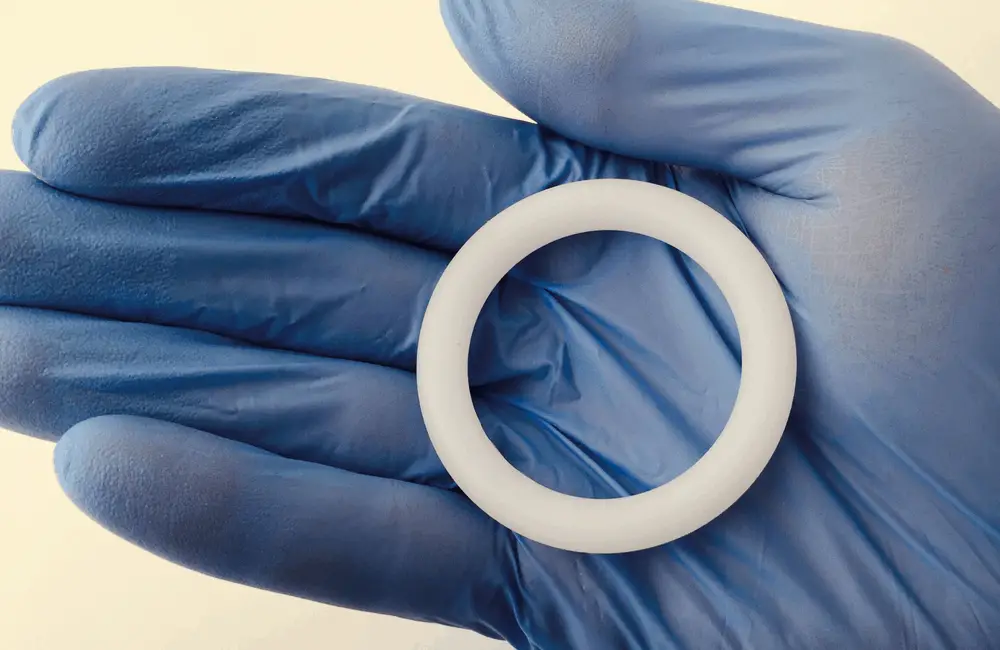The Vaginal Ring is a small, flexible, latex-free plastic ring. It (Nuva Ring) is an hormonal birth control device for women that is inserted into the vagina with the sole aim of preventing women from getting pregnant.
The device is about 2 inches round.
How Does the Vaginal Ring Work
The Vaginal Ring contains estrogens and progesterone which are important hormones in the sexual development of females.
These hormones are continuously being released and absorbed into the bloodstream through the walls of the vagina. The continuous absorption of these hormones into the bloodstream is what prevents women from getting pregnant by keeping the ovaries from releasing eggs to be fertilised.
These hormones also thicken the cervical mucus (a fluid or gel-like discharge from the cervix) which helps prevent sperm from reaching and fertilising the egg.
The hormones also perform a function of keeping the lining of the uterus thin, this preventing the implantation of a fertilised egg.
The continuous release of these hormones by the Vaginal Ring spans through a period of 3 weeks. This implies that, the ring is worn for a period of 3 weeks, after which it is removed for one week to have a ring-free week. During this ring-free week, the menstrual flow is expected to occur.
The woman is protected against getting pregnant during this ring-free week and then a new Vaginal Ring is inserted and the process repeats itself.
How the Vaginal Ring is Used
It is very simple to insert and remove the ring. To insert the ring;
- The hands must be properly washed using clean water and soap.
- Using the thumb and index fingers, squeeze the sides of the ring together so that it becomes narrow.
- Gently push the ring into the vagina until it feels comfortable
N/B: the Vaginal Ring should be removed 3 weeks after insertion and this should be done on same day of the week it was inserted.
To remove the ring,
- Wash hand thoroughly and hook the finger under the edge of the ring and gently pull.
- Place the used ring in the special bag provided and dispose in the bin. Don’t flush it down the toilet.
Removing the ring should be painless. If due to bleeding or pain one can’t pull the ring out, a medical professional should be consulted immediately.
Sometimes the ring may come out on its own after inserting in the vagina. This could happen during or after sex or if it is not properly inserted. In a situation like this, what one needs to do depends on how long the ring has been in the vagina before the ring came out.
If the ring is out for less than 3hours, rinse it with lukewarm water and then reinsert the same ring as soon as possible. In this situation, no additional contraceptive is needed and the individual is still protected from pregnancy.
If the ring has been out for more than 3 hours in the first or second week of insertion, then rinse with lukewarm water, reinsert same ring within 3 hours and the use of an additional is required for a period of 7days. An emergency contraception may be required in this instance if there has been any sexual activity in the last few days.
If the ring has been out for more than 3hours in the third week of insertion, the ring should be thrown away and a new ring inserted immediately.
Advantages of using the Nuva Ring

- It is easy to insert and pull out.
- It’s insertion does not interfere with or interrupt sex.
- There is no long term effect on fertility.
- Period-type bleeding becomes lighter, more regular and even less painful.
Disadvantages
- Not everyone will feel comfortable inserting and pulling out a ring from their vagina
- The ring doesn’t confer immunity against Sexually Transmitted Diseases.
- Some drugs can make the ring less effective.
- The ring may cause temporary side effects like increased vaginal discharge, breast tenderness, nausea etc.












